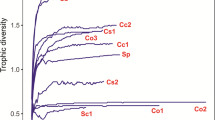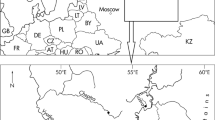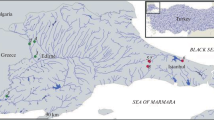Summary
Feeding relationships between roach and ide from two sites in a mesotrophic lake SE Norway are presented and discussed. When animal food supply was scarce, both fish species increased their consumption of macrophytes; roach sevenfold, and ide threefold. Along a typical littoral vegetation gradient, ide fed among helophytes, while roach fed in the zone outside. This different habitat selection was reflected in the most important plants consumed (ide: Equisetum fluviatile, roach: Characeae), and confirmed by gill net catches. During the vegetative season, roach avoided areas with dense vegetation. In shallow areas beyond the littoral, the most important food plant for both fish species was Potamogeton perfoliatus, which constituted 80% of the total food consumed (dry weight basis) in the roach and 35% in the ide. The diet shift to plants seemed to be strongly influenced by the supply of animal food and the intensity of intra-and interspecific competition.
Similar content being viewed by others

References
Andersson G, Berggren H, Cronberg C, Gelin C (1978) Effects of planktivorous and benthivorous fish on organisms and water chemistry in eutrophic lakes. Hydrobiologia 59:9–15
Backe-Hansen P (1982) Age determination, growth and maturity of the bleak Alburnus alburnus (L.) (Cyprinidae) in lake Øyeren, SE Norway. Fauna Norv Ser A3, 31–36
Bohl E (1980) Diel pattern of pelagic and feeding in planktovorus fish. Oecologia (Berlin) 44:368–375
Brabrand Å (1984) Microhabitat segregation between bream (Abramis brama (L.)) and white bream (Blicca bjoerkna (L.)) in a mesotrophic lake, SE norway. Pol Arch Hydrobiol 31:99–108
Brabrand Å, Faafeng BA, Källqvist T, Nilssen JP (1984) Can iron defecation from fish influence phytoplankton production and biomass in eutrophic lakes? Limnol Oceanogr 29:1330–1334
Brabrand Å, Faafeng BA, Nilsson JP (1985) Fish nutrient dynamics in a deep mesotrophic lake. Verh Internat Verein Limnol 22:2553
Cala P (1970) On the ecology of the ide Idus idus (L.) in the river Kävlingeån, south Sweden. Rep Inst Freshwat Res Drottningholm 50:45–99
Eie JA, Borgstrøm R (1978) Distribution and food of roach (Rutilus rutilus (L.)) and perch (Perca fluviatilis L.) in the eutrophic lake Årungen. Norway Verh Internat Verein Limnol 21: 1257–1263
Hansen LP (1978) Forekomst og fordeling av noen fiskearter i Nordre Øyeren. (Abundance and distribution of some fish species in northern part of lake Øyeren). Fauna 31:175–183
Hartley PHT (1947) The natural history of some British freshwater fishes. Proc Zool Soc Lond 117:129–254
Kempe O (1962) The growth of the roach (Leuciscus rutilus L.) in some Swedish lakes. Rep Inst Freshw Res Drottningholm 44:42–104
Lessmark O (1983) The utilization of plant material for metabolism and growth by roach (Rutilus rutilus). In: Competition between perch (Perca fluviatilis) and roach (Rutilus rutilus) in south Swedish lakes. Doctoral Dissertation, p 172
Mann KH (1965) Energy transformations by a population of fish in the river Thames. J Anim Ecol 34:253–273
Persson L (1983) Food consumption and the significance of detritus and algae to intraspecific competition in roach Rutilus rutilus in a shallow eutrophic lake. Oikos 41:118–125
Prejs A (1973) Experimentally increased fish stoch in the pond-type Lake Warniak. IV. Feeding of introduced and autochtonous non-predatory fish. Ecol Pol 21:465–505
Prejs A (1978) Lake macrophytes as the food of roach (Rutilus rutilus L.) and rudd (Scardinius erythrophtalmus L.) II. Daily intake of macrophyte food in relation to body size of fish. Ecol Pol 26:537–553
Ricker WE (1968) Methods for assessment of fish production in fresh waters. IBP handbook 3. Blackwell, Oxford
Sorygin AA (1939) Pitanie, izbiratel ‘noja sposobnost’ i pishchevye vzaimootnoshenija nekotorykh Gobiidae Kaspijskogo morja. (Foods and food preference of some Gobiidae of the Caspian sea). Zool Zh 18:27–53
Stenson J (1975) Fish predation effects on the species composition of the zooplankton community in eight small forest lakes. Rep Inst Freshwat Res Drottningholm 52:132–147
Svärdson G (1975) Interspecific population dominance in fish communities of Scandinavian lakes. Rep Inst Freshwat Res Drottningholm 55:144–171
Author information
Authors and Affiliations
Rights and permissions
About this article
Cite this article
Brabrand, Å. Food of roach (Rutilus rutilus) and ide (Leusiscus idus): significance of diet shift for interspecific competition in omnivorous fishes. Oecologia 66, 461–467 (1985). https://doi.org/10.1007/BF00379334
Received:
Issue Date:
DOI: https://doi.org/10.1007/BF00379334



